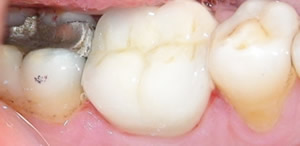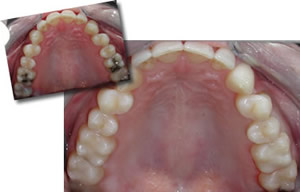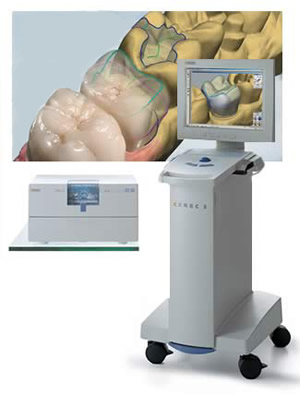CAD CAM
The Number One CAD CAM Clinic In Beirut Lebanon
CAD/CAM
 Ferrari dental clinics offer you the CAD/CAM technology! Imagine the anatomical features, size and shape of your tooth restorations designed on a computer!
Ferrari dental clinics offer you the CAD/CAM technology! Imagine the anatomical features, size and shape of your tooth restorations designed on a computer!
CAD/CAM Dentistry, (Computer-Aided Designand Computer-Aided Manufacturing in Dentistry), is an area of dentistry utilizing CAD/CAM technologies to produce different types of dental restorations, including crowns, veneers, inlays and onlays, fixed bridges, dental implant restorations and orthodontic appliances.
Veneers designed by CAD CAM Technology:

 CAD/CAM technology is that allows a typical two-visit tooth restoration to be accomplished in one visit, provided that the dentist has the technology in the office (chairside CAD/CAM- CEREC).
CAD/CAM technology is that allows a typical two-visit tooth restoration to be accomplished in one visit, provided that the dentist has the technology in the office (chairside CAD/CAM- CEREC).
The CAD/CAM computer screen displays a 3-D custom image of your teeth and gums, allowing your dentist to use a cursor to draw the precise design of the tooth restoration. The CAD/CAM machine fabricates the restoration through a milling chamber that crafts the tooth-like ceramic material into a precise replica of the drawing.
The components of a CAD/CAM unit:
 1. The Acquisition Unit:
1. The Acquisition Unit:
The acquisition unit is made up of a tower with a computer inside it, an LCD computer screen, and camera unit for imaging teeth and program software for creating dental restorations.
 2. The Milling Unit
2. The Milling Unit
This is a box shaped chamber that is separate from the acquisition unit. It wirelessly receives directions from the acquisition unit and mills (cuts) crowns, onlays, inlays and veneers from porcelain or composite (acrylic) blocks. The milling unit features a self-contained water supply and 2 diamond coated burs that create the specified shape of computer designed restorations.
- If the CAD/CAM equipment is located at a dental lab rather than the dental office: A two-visit restoration is necessary.
- If the CAD/CAM equipment is located in the dental office: Your dentist does not need to create a molded impression of your teeth and, there may be no need for a temporary restoration or a return visit to the office for a permanent restoration. This is what CEREC technology by Sirona Dental Systems UK has made possible.
 What is CEREC?
What is CEREC?
CEREC is a revolutionary system that enables your dentist to design, fabricate and fit a new crown, veneer, onlay or inlay in a single visit, a procedure that would normally take at least two weeks, if not more!
How does this CEREC technology work?
 Your dentist will prepare your tooth in the normal way he would before fitting a crown or a veneer. At this point, instead of using "dental putty" to take an impression of your tooth, a digital image is taken using a special camera. This image is then converted into a 3D computerized model of your tooth, which is used as a guide to design your new restoration. Once your dentist is happy with the newly designed tooth, this data is sent to an onsite-milling machine, which fabricates your new tooth from a high-quality ceramic block. The milling process can take anywhere from as little as 6 minutes to 30 minutes depending on the exact technology and complexity of the tooth.
Your dentist will prepare your tooth in the normal way he would before fitting a crown or a veneer. At this point, instead of using "dental putty" to take an impression of your tooth, a digital image is taken using a special camera. This image is then converted into a 3D computerized model of your tooth, which is used as a guide to design your new restoration. Once your dentist is happy with the newly designed tooth, this data is sent to an onsite-milling machine, which fabricates your new tooth from a high-quality ceramic block. The milling process can take anywhere from as little as 6 minutes to 30 minutes depending on the exact technology and complexity of the tooth.
The ceramic blocks come in a wide variety of shades and colors, and your tooth will be selected to match your surrounding teeth. Once the crown or veneer has been milled, the dentist may characterize it and stain it to match your surrounding teeth, before either polishing it or glazing it in a furnace. Your new restoration will then be cemented into place onto your prepared tooth.
This patient came with a fractured porcelain veneer on his lower incisor, using CEREC/ CAD CAM technology a porcelain veneer was designed and milled out in an hour. the final result met the patient's high esthetic demands.

What are the benefits of CEREC?
There are several advantages to having treatment with CEREC over conventional, laboratory-made restorations:
Everything is carried out in a single visit - you only need to visit the dentist once - take one day away from your work or life to have the procedure - instead of the usual two or three visits.
Only one set of local anaesthetic injections - since the entire procedure can be carried out within the hour, you only need to have one lot of injections.
Your dentist is in complete control of the final result - since the crown or veneer is designed and fabricated from start to finish by your dentist, he/she has total control over how it will look and fit, whereas a crown made in a laboratory is under the control of the technician who hasn't even seen the patient.
No temporary restorations - if you have lab-made veneers, you would require temporary veneers during the wait for your new teeth. These have been known to fall off and cause problems, which is a step that is omitted with CEREC restorations.